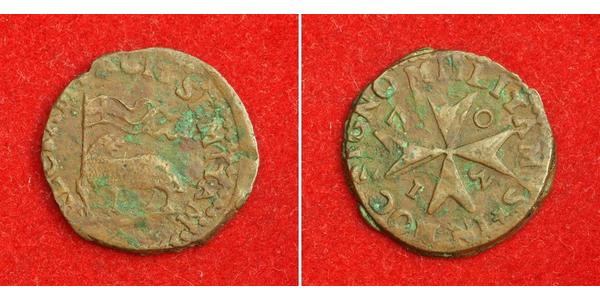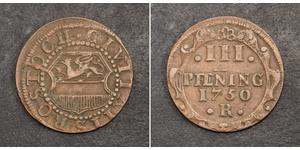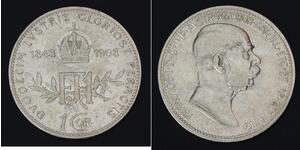(sold for $123.0)
Mint Year: 1703
Mint Place: Valetta
Denomination: Grano
Reference: KM-140 ($120 in XF!).
Condition: Minor greenish deposits, double-struck reverse, otherwise about XF for type!
Material: Copper
Diameter: 20mm
Weight: 3.35gm
Obverse: Lamb of God left, holding banner of the Malta and looking back.
Legend: RECTAM . FACIT . SEMITAM .
Reverse: Maltese cross divides date (1703) in fields. Legend around.
Legend: IN . HOC . SIGNO . MILITAMVS
Ramon Perellos y Roccaful (also known as Raimundo Rabasa de Perellós y Rocafull) (1637 in Valencia – 10 January 1720 in Valleta) was the 64th Prince and Grand Master of the Order of Malta from 1697 until his death. He was of Spanish origin and was 60 years old when he was elected as Grand Master.
Ramon Perellos (1637-1720) was the son of the Eighth Lord of Benetússer and Fifth Baron of Dos Aguas and of María de Rocafull y Vives de Boil, his consort. He joined the Order of Malta at the age of sixteen following family tradition. In 1658 he joined the board of the Master and in 1697 was elected Grand Master and remained so until his death in 1720.
Malta had organised the Consulato del Mare (Consulate of the Sea) for the first time on 1st September 1697 per initiative of Grandmaster Perellos. At the consulate it was decided that four merchants familiar enough with maritime procedures shall be appointed consuls to administer justice, on similar approach to Barcellona and Messina. Perellos had established foreign relations between Malta and Russia in 1698, for the first time, exactly a century before the Order's expulsion from Malta. During his grandmastership the coastal fortifications of Malta were strengthened by the construction of batteries, redoubts, and entrenchments. He also was the driving force behind the third rate squadron of the order which was eventually inaugurated in 1705. In 1707 he entrusted Romano Carapecchia with the reorganization of the drainage system in Valletta.
He died after 22 years as a ruler, due to illness and old age. His coat of arms was represented by three black pears against a golden background. His funerary monument is found in the Co-Cathedral of St. John in Valletta and is considered to be one of the best examples of baroque art in Malta.
Soon after his appointment, Ramon Perellos became very active in correcting cases of corruption and abuse within the Order. One such case involved the request by knights to receive graces and be nominated to the title of Gran Croce di Grazia (literally: great cross by grace). This title implied that a graced knight could replace a knight of the Great Cross upon the latter's death. This procedure was not well reputed among elder knights who spent their lifetime at the service of the Order, and resulted in many of them retiring to return to their homelands and leave their inheritances to their respective families, against the rules of the Order. The pleas of Perellos to eliminate such prejudicial recommendations were considered legitimate by Pope Innocent XII who agreed to forbid them.
Perellos dedicated many of his efforts to stop the attacks at sea by Ottoman pirates, who would sail along the coasts of Spain and Italy to plunder merchant ships and enslave civilians. He ordered the knight of St. Pierre of the French Royal Naval Fleet to build a new war fleet to fight the Ottoman scourge. Meanwhile, the old galleys, together with the might of a vessel armed with 80 cannons, waged war at sea against the pirates.
The Grand Master's new fleet was ready in port by 1706 and was headed by the same knight of St. Pierre. Three large vessels were launched that year by the names St. Vincent, St. Joseph and St. Raymond. Shortly afterwards, the fleet sailed west, where they encountered three Tunisian vessels, one of which was seized and incorporated into the fleet under the name of Santa Croce.
One year later, the commanding knight Giuseppe de Langon, surrounded Oran and with his sole vessel, which harbored a force of 50 cannons, traversed the entire enemy fleet despite the vain efforts of the Algerians to catch him. He was subsequently nominated Lieutenant General of the Maltese fleet.
In 1709, the Grand Master's fleet anticipated and repelled eight Turkish vessels which attempted to infiltrate the island of Gozo. During the same year, the Grand Master sent part of his fleet to also repel a Turkish unit which was threatening Calabria. Headed by the commanding knight of Langon, the fleet managed to sink an admiral ship. In the following year the commanding knight of Langon was defeated at sea after attacking an Algerian admiral vessel. Nevertheless, the Maltese fleet emerged victorious. Between 1713 and 1715, the fleet of the Order patrolled all the coasts around the Mediterranean succeeding in various important undertakings.
During the rule of Grand Master Perellos, the Order was amassing great wealth. The Inquisitor Delci desired to garner greater power in Malta and attempted to take hold of the Order's hospital. This hospital was a privileged place and nobody could be admitted prior to presenting their honorary crests, however the inquisition's officers infiltrated the hospital and commenced a formal inspection. These were soon ordered to leave the premises by the commanding knight of Avernes de Bocage, who was the hospital's supervisor. This news reached Grand Master Perellos, who sent his emissary, the Great Prior Marc'Antonio Zondadari, to the Court of Rome to forward complaints about the incident.
During the years preceding the siege of Venice, it was believed that the Ottoman Empire had preparations underway to attack Malta. This suspicion became stronger when a well-groomed man, who had approached the Order to serve as engineer and offer his wealth of knowledge about fortifications, disappeared shortly after having surveyed Malta's fortifications. Consequently, the Order began its preparations to counter any possible attack by the Ottoman army.
Possibly alarmed by Malta's preparations, the Ottoman sultan directed his attention to the Republic of Venice, with which he declared war in 1716. In reply to a plea for assistance, the Grand Master Perellos lent five of his warships and a few galleys to repel the Ottoman invasion.
The Knights Hospitaller (also known as the Sovereign Military Hospitaller Order of St. John of Jerusalem of Rhodes and of Malta, Order of St. John, Knights of Malta, and Chevaliers of Malta; French: Ordre des Hospitaliers, Maltese: Ordni ta' San Gwann) was a Christian organization that began as an Amalfitan hospital founded in Jerusalem in 1080 to provide care for poor, sick or injured pilgrims to the Holy Land. After the Western Christian reconquest of Jerusalem in 1099 during the First Crusade it became a religious/military order under its own charter, and was charged with the care and defense of the Holy Land. Following the conquest of the Holy Land by Islamic forces, the Order operated from Rhodes, over which it was sovereign, and later from Malta where it administered a vassal state under the Spanish viceroy of Sicily.
The Order lost many of its European holdings following the rise of Protestantism and French Egalitarianism, but survived on Malta. The property of the English branch was confiscated in 1540. In 1577, the German Bailiwick of Brandenburg became Lutheran, but continued to pay its financial contribution to the Order until the branch was turned into a merit Order by the King of Prussia in 1812. The "Johanniter Orden" was restored as a Prussian Order of Knights Hospitaller in 1852.
The Knights of Malta had a strong presence within the Imperial Russian Navy and the pre-revolutionary French Navy. When De Poincy was appointed governor of the French colony on St. Kitts in 1639 he was a prominent Knight of St. John and dressed his retinue with the emblems of the Order. In 1651, the Knights bought from the Compagnie des Îles de l'Amérique the islands of Sainte-Christophe, Saint Martin, and Saint Barthélemy. The Order's presence in the Caribbean was eclipsed with De Poincy's death in 1660. He had also bought the island of Saint Croix as his personal estate and deeded it to the Knights of St. John. In 1665, the order sold their Caribbean possessions to the French West India Company, ending the Order's presence in that region.
The decree of the French National Assembly Abolishing the Feudal System (1789) abolished the Order in France: V. Tithes of every description, as well as the dues which have been substituted for them, under whatever denomination they are known or collected (even when compounded for), possessed by secular or regular congregations, by holders of benefices, members of corporations (including the Order of Malta and other religious and military orders), as well as those devoted to the maintenance of churches, those impropriated to lay persons and those substituted for the portion congrue, are abolished (...) (The Decree Abolishing the Feudal System, August 11, 1789, J.H. Robinson, ed., Readings in European History 2 vols. (Boston: Ginn, 1906), 2: 404-409) The French Revolutionary Government seized the assets and properties of the Order in France in 1792.
Only 1$ shipping for each additional coin purchased!

|
Posted by:
anonymous 2016-08-19 |
1 Corona Austria-Hungary (1867-1918) Silver Franz Joseph I ( ...
group has 25 coins / 17 prices
⇑















-300-150-AeIKqUpY7NEAAAFhroEy54Nz.jpg)







